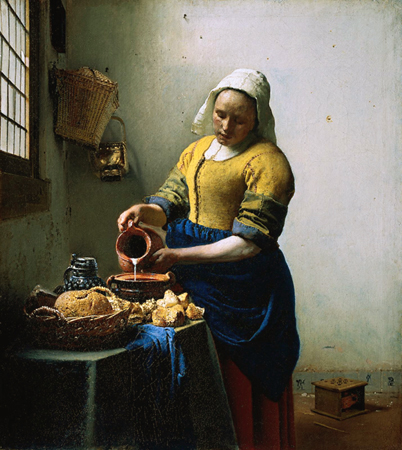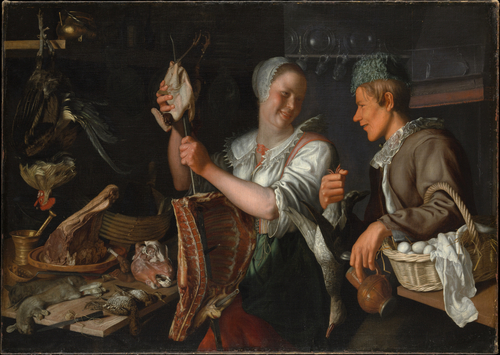|
Sexual reductionism at the Met
The Metropolitan Museum of Art currently has an exhibit of the work of the 17th century Dutch painter Johannes Vermeer, where his most famous painting, The Milk Maid, is on display in the United States for only the second time. The text accompanying the paintings is like no art criticism or commentary I’ve ever read. It finds erotic messages everywhere in these paintings, even where the viewer wouldn’t remotely think of them, and treats them as the most important thing.
 The young woman in The Milkmaid is stout, hardy, gravely concentrated on her work. Her stiff blouse looks more like a coat of armor than a woman’s garment. She is the most non-erotic, non-romantic female in a painting you’ve ever seen. Yet the authors of the exhibit text on the plaque next to the painting tell us that she is immersed in an erotic reverie and that the painting is full of sexual, titillating messages. For example, there is a small image of a Cupid on the wall behind a foot warmer. The supposed Cupid is so tiny that you can’t make it out as a Cupid even when they tell you it’s a Cupid. Yet they say that this invisible Cupid represents the woman’s erotic thoughts. They make this indecipherable supposed Cupid—basically a spot on the wall that you wouldn’t even notice unless they drew your attention to it—the governing element in the painting. We’re also told that the foot warmer, a nondescript box on the floor, is a symbol of sexual arousal. And we’er told that men looking at the painting will feel sexually aroused by it.
 The exhibit reminded me of the Darwinian Roissyites, with their reduction of men and women to sexual stimulus-response machines. See, for example, Chuck Ross’s “Dual Hotness Scale” at Gucci Little Piggy. It’s the full bore Roissy-Darwinian approach to sexuality, in which the Roissyite clinician “scientifically” analyzes women as collections of body parts, assigning a numerical value to each part based on how much arousal it causes in men. That’s where our culture is. The Darwinians, including the Darwinian “conservatives” (and I wonder how Chuck Ross can see his article as compatible with conservatism), walk hand in hand with the left in its program of supposedly liberatory but really repressive desublimation, redefining human beings as nothing but packages of desire and that which provokes desire.
Lydia McGrew writes:
What you recount about the Met exhibit is really disturbing. I guess we shouldn’t listen to people who tell us that postmodernism is burning itself out in the university, going out of style, so we don’t need to worry about it anymore. Think of young people who see Vermeer—Vermeer—for the first time with that kind of commentary.Rohan Swee writes:
Re your thoughts on the Vermeer exhibition: over time I have come to see that we live in and among a pathologically literal-minded age and people. Once I realized this, a great deal of what was utterly perplexing—or apparently incomprehensibly stupid—in people’s words and behavior became explicable. There are simply whole realms of imagination, whole vistas of understanding, that I took for granted, that I assumed to be shared, that are not. Seen in this light, the feverish banalities of the sort of bloggers you reference are at least no longer utterly mystifying. They are struggling within their limitations. Here is, to use the old phrasing, a “want of parts”, a tragic (criminal, on the part of their elders?) stunting of capacity, as if they’d been starved of some vital nutrients, locked in cognitive closets, at a crucial age, resulting in irremediable damage.Richard Hoste writes:
I don’t know if you’ve ever read Tenured Radicals (not worth it if you didn’t), but apparently this kind of stuff is normal in art criticism. Every pointy thing is a penis and all holes are vaginas. It’s only when I hear about what goes on in modern art and literary theory that I truly sympathize with totalitarian right wing regimes that once rounded up trash like this.LA replies:
Sure. But not at the Met.Richard Hoste replies:
I’ll take your word for it. When I hear “artist” or “art critic” at this point I automatically think degenerate pervert until I see a reason to think otherwise. It’s sad, I know. [LA replies: But that wouldn’t be fair. For example, Philip de Montebello, the recently retired long time director of the Met, who personally recorded the audio tour guides of exhibits, did not take a decadent approach to art at all. But the Met may be changing.] I was in Russia not too long ago and a young girl told me she was a photographer. I asked to see some of her work. It was all pictures of garbage, rubble, dead dogs and disturbing collages that looked like nothing. I almost threw it in her face. Then I thought to myself I should’ve expected it.Kristor writes:
Reductionism is appealing because ideas that are good candidates for it do indeed seem to explain a lot of things. Freud was correct that almost anything can serve as a sexual symbol, and that many times our behavior is covertly or symbolically sexual. But that doesn’t mean everything is a sexual symbol, or that everything we do is nothing but sex. Freud was also correct that sometimes a cigar is just a cigar. But people discover a powerful idea, and they get carried away with it. They’ve got a hammer and they use it on everything: screws, muskrats, you name it. Bottom line is that reductionist doctrines are completely susceptible to arguments of retortion, as they are called: if everything is nothing but x, then “everything is nothing but x” is x. Reality is complex. It is more complex than any system of terms or their relations that we might devise, by which we would refer to it. This fact is a truth of logic.LA replies:
You wrote:Nick writes:
Incidentally, I saw the Frick Collection today for the first time, and they had a few Vermeer paintings which were very striking, particularly “Soldier and a Girl”. Funny how he always seems to paint against an East-facing open window. It was just about the least sexual imagery I’ve ever seen. Incidentally the woman in “Soldier and a Girl” does seem attractive somehow. In viewing the Frick collection I noticed especially to the beauty of the women of the 19th century depicted there, particularly in portraiture. They did not look notably different from the women of today in facial appearance, but looked utterly foreign in attire and composition.LA replies:
Yes, I was noticing that at the Met Friday evening. He shows a woman in a room, and the window of the room is always to the woman’s right (the viewer’s left), with the light from the window subtly bathing the room from the woman’s right.Marco Jawsario writes:
I have said it before and I will say it again. I no longer wish to share a country and a culture with perverts who try to debase the classic works of art as if they were recently painted by some sexually obsessed libertine living in Greenwich Village. These nihilists go out of their way to deprive us of the simple joys of life. You do us a great service, Sr. Auster, by bringing these matters to light. At times like this, an aging but still dashing caballero such as myself feels duty bound to mount his noble potrillo (steed) and run his lance through this scoria (scum).Chuck Ross writes:
Oftentimes on my blog I like to make ad absurdum points about minor issues. The Dual Hotness Scale is one; I posted something else a while back about how a parking lot cat was staring at me while I was urinating on a tree. I grew up with a healthy dose of “Seinfeld” and enjoy picking nits about minor occurences; I find it humorous.LA replies:
Just so people know what we’re talking about, here is the beginning of Chuck’s post in which, according to his above comment, he didn’t mean to be reducing women to body parts. He coulda fooled me. To me, the entry is very similar to Roissy, except that Roissy is angry and pornographic, while Chuck is genial. But geniality doesn’t get rid of the basic problem of the instrumental way in which materialists and Darwinists look at human beings.October 12 Mark P. writes:
Just a few points on the art criticism:LA replies:
Why couldn’t the East be to the right in the painting, or any direction? Do we know for a fact that whenever the interior of a room is painted, the viewer is always looking toward the South, with the East to the viewer’s left?The Dutch blogger Snouk Hurgronje writes:
Great discussion about Dutch paintings! I agree with the Met that the painting of Wtewael (he lived a bit earlier than Vermeer I think) has sexual imagery. The couple is clearly flirting like you noted. A lot of the codes in Dutch paintings are Germanic I think. The Met seems to have missed the cue of the eggs. The man is carrying a basket of eggs, denoting fertility. [LA replies: They did mention that.] Think of the custom of Easter eggs which are a holdover of an old Germanic fertility rite. Then combine this with the chicken on the spit. However I agree with you that it does not represent female genitalia. That is reducing the woman to her parts. On its own it would not mean anything, but taken together this is a very rude and lewd joke. You would not want to introduce your daughter to that Wtewael! The meaning of the man’s hand on the lid of the beer jug becomes that the man holds the key to this woman’s lust. I do think this last cue is indeed pointing to the female’s parts, this is my agreement with the Met. But you are also right, it is not just her parts. She is like puttee in his hands. I think if you just point the viewers to the eggs, the chicken on the spit and the finger on the beer jug, many will make the right deductions. The painting is a moral study. Typical of Dutch painters of that period. And Wtewael is something of a pornographer, if you ask me. The moral study is just an excuse for a lewd scene for him.LA replies:
There’s even more to this, about how the Met artificially associated the non-sexual Milk Maid with the highly sexual Kitchen Scene in order to make its absurd sexualization of the former seem more plausible. I’ll add that later today.Carol Iannone writes:
Mark P.s comment seems reductive a la Roissy. Critics influenced by academia are collaborating in making fatties seem sexy in order to cheer up their chubby thirtysomething female colleagues?LA replies:
I comment on Carol Iannone’s comment in a new entry.Kristor writes:
Maybe it’s because I’ve been following the huge discussion over at Thinking Housewife about obesity, carbs, protein, etc., but I’ve been looking at Wtewael’s Kitchen Scene, and for the life of me I can’t see the sexuality that supposedly suffuses it. To me the painting looks like it’s all about food. Specifically, protein. These two people in the painting are surrounded by eggs and meat. No wonder they are so happy! And so healthy looking!LA replies:
That’s a riot.October 17 The Dutch blogger Snouk Hurgronje writes:
You wrote at the end of the discussion on Dutch painters: Posted by Lawrence Auster at October 11, 2009 04:35 PM | Send Email entry |